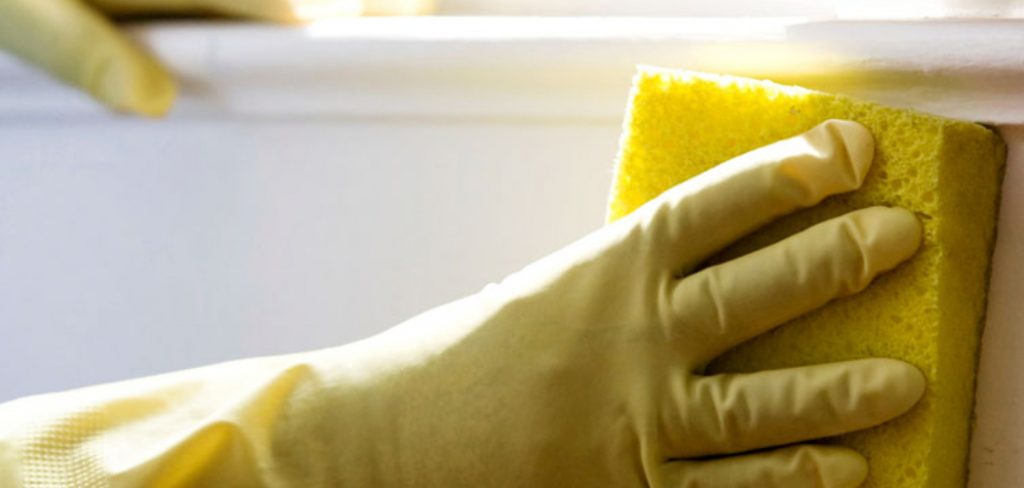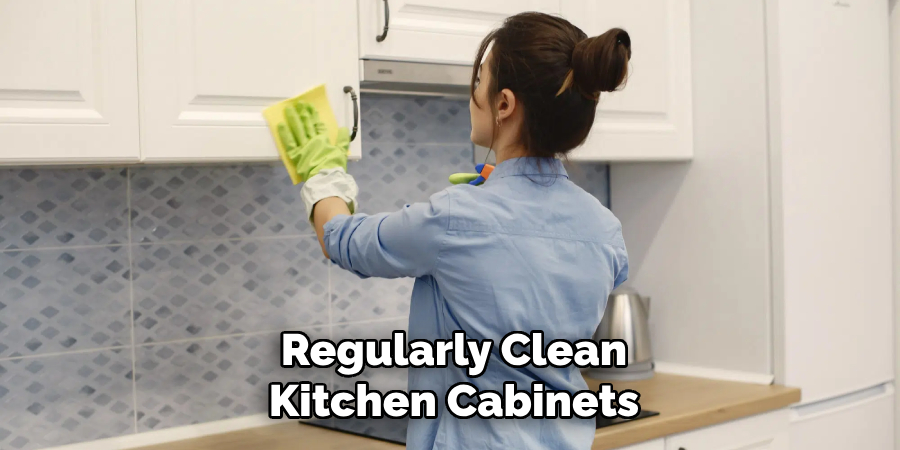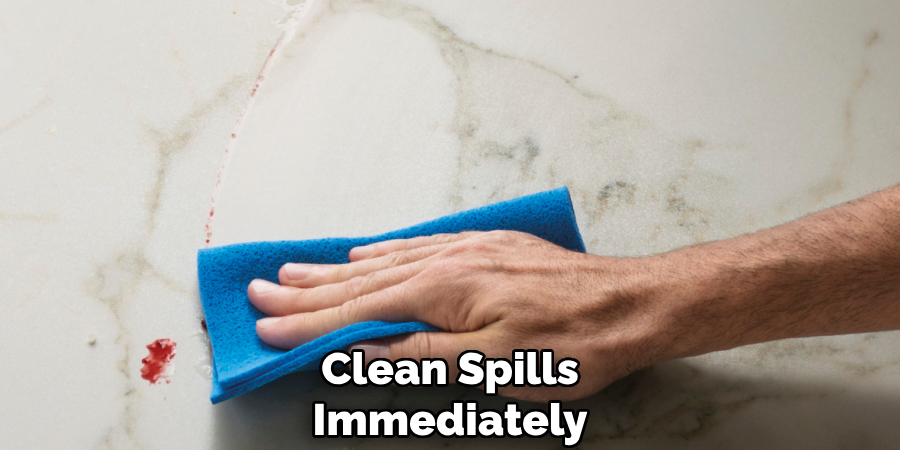Kitchen cabinets are an essential component of any culinary space, providing storage and organization while adding to the room’s overall aesthetic. However, they often bear the brunt of daily cooking activities, particularly when it comes to grease accumulation. Over time, grease can build up on cabinet surfaces, leading to unsightly stains and potentially lasting damage.

Protecting your kitchen cabinets from grease not only maintains their appearance but also extends their lifespan, ensuring that your kitchen remains a beautiful and functional area. In this guide on how to protect kitchen cabinets from grease, we will explore practical and effective strategies to safeguard your cabinets from the adverse effects of cooking grease.
Why is It Important to Protect Kitchen Cabinets From Grease?
Grease stains on your kitchen cabinets can be challenging and sometimes impossible to remove, depending on the cabinet materials and finish. It not only creates a dingy appearance but can also result in discoloration, warping, and even structural damage. Grease buildup can also attract dust and other particles, making it harder to clean and maintain your cabinets’ overall cleanliness.
Moreover, if left unchecked, grease buildup on cabinet surfaces can harbor bacteria and become a health hazard in the kitchen. It is essential to protect your kitchen cabinets from grease to ensure not only their longevity but also the safety and hygiene of your cooking space.
8 Step-by-step Guidelines on How to Protect Kitchen Cabinets From Grease
Step 1: Regularly Clean Your Kitchen Cabinets
One of the most effective ways to protect your kitchen cabinets from grease is to establish a routine cleaning schedule. Regularly wiping down cabinet surfaces with a gentle cleaning solution can prevent grease from building up and becoming stubborn. Use a mixture of warm water and mild dish soap or a dedicated cabinet cleaner to gently scrub away grease and grime.

Be sure to utilize a soft cloth or sponge to avoid scratching the cabinet surface. Focus on areas that are frequently exposed to grease, such as those near the stove or oven. By maintaining a consistent cleaning habit, you can keep your cabinets looking fresh and prolong their lifespan.
Step 2: Invest in Quality Cabinet Hardware
Kitchen cabinets with handles and knobs often accumulate grease buildup, making it challenging to maintain their appearance. Investing in high-quality cabinet hardware can make a significant difference in preventing grease accumulation. Look for finishes that are easy to clean and resistant to fingerprints, such as brushed nickel or stainless steel.
Additionally, opt for hardware with smooth and simple designs that do not have intricate crevices where grease can hide. This makes cleaning easier and more effective.
Step 3: Use Protective Mats or Liners
Another effective way to protect your kitchen cabinets from grease is by using protective mats or liners on shelves and inside drawers. These liners act as a barrier between cabinet surfaces and potential spills or splatters from cooking.
Choose liners that are waterproof and can be easily removed for cleaning. They not only protect cabinets from grease but also make it easier to keep your kitchen organized and tidy.
Step 4: Avoid Cooking Near Cabinets
Prevention is always better than cure, so avoiding cooking near your cabinets altogether can significantly reduce grease buildup. If possible, position your stove or oven further away from adjacent cabinets.
This will prevent splattering grease from reaching the cabinets and minimize the need for frequent cleaning.
Step 5: Utilise Exhaust Fans
Exhaust fans are a valuable tool in preventing grease accumulation in kitchen cabinets. They work by extracting steam and smoke from cooking, reducing the amount of grease that can settle on cabinet surfaces.
Be sure to use your exhaust fan whenever you are cooking, especially when frying or grilling foods that produce a lot of oil and steam.

Step 6: Wipe Down Cabinets After Cooking
After cooking, take a few minutes to wipe down kitchen cabinets with a damp cloth or sponge. This quick cleaning routine can prevent grease from settling and becoming more difficult to remove later on.
Also, be sure to close cabinet doors and drawers while cooking to minimize exposure to steam and grease.
Step 7: Deep Clean Regularly
While regular cleaning is essential, it’s also crucial to deep clean your kitchen cabinets occasionally. A deep clean involves removing all items from the cabinets and thoroughly washing both the interior and exterior surfaces.
This process removes any accumulated grease that may have been missed during routine cleaning and helps maintain the cabinet’s finish and appearance.
Step 8: Consider Adding a Protective Sealant
If your kitchen cabinets are made of wood, adding a protective sealant can be an effective measure to prevent grease from penetrating the surface. A sealant creates a barrier that repels liquids and makes it easier to clean off any spills or splatters.
Be sure to use a sealant specifically designed for cabinetry, and follow the manufacturer’s instructions carefully.
Tips for Protecting Kitchen Cabinets From Grease
Here are some practical tips to help you keep your kitchen cabinets free from grease buildup:
1. Regular Cleaning
One of the most effective ways to prevent grease stains on your cabinets is through regular cleaning. Wiping down cabinet surfaces at least once a week can prevent grease from building up and becoming difficult to remove.
2. Use Grease-fighting Products
When cleaning kitchen cabinets, opt for products specifically designed to cut through grease and grime. These cleaners will be more effective in removing stubborn grease stains compared to regular dish soap or water.
3. Take Precautions While Cooking
Be mindful of where you are cooking and take precautions to avoid splattering grease onto your cabinets. Avoid overcrowding pans, use spatter guards when frying, and always keep a lid nearby to cover pots and pans if necessary.
4. Clean Spills Immediately
If any spills occur while cooking, be sure to clean them up immediately. This will prevent the grease from settling and becoming harder to remove later on.

5. Use Microfiber Cloths
When cleaning kitchen cabinets, use microfiber cloths instead of paper towels. Microfiber is more effective in picking up and trapping grease particles, making it easier to achieve a streak-free finish.
6. Invest in Quality Cleaning Tools
Having the right cleaning tools can make a significant difference in maintaining your kitchen cabinets’ appearance. Opt for gentle scrubbers and sponges that won’t scratch cabinet surfaces but are still effective in removing grease buildup.
Following these steps and tips on how to protect kitchen cabinets from grease will not only keep your kitchen cabinets looking clean and fresh but also prolong their lifespan. By taking preventative measures and staying on top of regular cleaning, you can enjoy beautiful, grease-free cabinets for years to come.
Frequently Asked Questions
Q: How Often Should I Deep Clean My Kitchen Cabinets?
A: It is recommended to deep clean your kitchen cabinets at least once a year. However, if you notice significant grease buildup or stains, it may be necessary to do it more frequently. The frequency of deep cleaning also depends on how often you use your kitchen and cook with oils or greasy foods.
Q: Can I Use Vinegar to Clean Grease Off My Cabinets?
A: Yes, a mixture of equal parts white vinegar and water can be an effective natural cleaner for removing grease from kitchen cabinets. However, be sure to spot test first as vinegar may damage certain finishes.
Q: Are There Any Home Remedies for Removing Grease from Cabinets?
A: In addition to vinegar, other household items such as baking soda, lemon juice, and dish soap can also be effective in removing grease stains from cabinets. However, it is important to spot tests first and use caution when trying any homemade remedies. Be sure to follow up with a regular cleaning using grease-fighting products for best results.
Q: Can I Use a Power Washer to Clean Kitchen Cabinets?
A: No, power washers are not suitable for cleaning kitchen cabinets as the high pressure can damage cabinet surfaces and finishes. Stick to gentle cleaning methods such as wiping with a damp cloth or sponge. Overall, it is important to regularly clean and maintain your kitchen cabinets to keep them looking their best and protect them from grease buildup.
By following these tips and incorporating them into your cleaning routine, you can easily prevent and remove grease stains on your cabinets for a beautiful and functional kitchen space.

Conclusion
By following these simple steps and tips on how to protect kitchen cabinets from grease, you can protect your kitchen cabinets from grease and maintain their appearance for longer. Remember to invest in quality cabinet hardware, use protective mats or liners, avoid cooking near cabinets, utilize exhaust fans, wipe down cabinets after cooking, deep clean regularly, and consider adding a protective sealant for added protection.
With proper care and maintenance, your kitchen cabinets will remain a beautiful focal point in your home. So, be sure to incorporate these tips into your cleaning routine and enjoy grease-free cabinets for years to come!
About the Author
Adrian Green, a lifelong woodworking enthusiast, shares his passion for the craft through The Woodenify Blog. With a foundation built on years of hands-on experience in his father’s woodworking shop, Adrian is dedicated to helping others learn and grow in the world of DIY woodworking. His approach to woodworking combines creativity, practicality, and a deep appreciation for the art of building with your own hands. Through his blog, he inspires individuals of all skill levels to embark on their own woodworking journeys, creating beautiful, functional pieces of furniture and décor.
Professional Focus
- Specializes in DIY woodworking projects, from furniture to home décor.
- Provides step-by-step guides and practical tutorials for woodworkers of all skill levels.
- Dedicated to helping readers build confidence and skill through easy-to-follow instructions and tips.
- Passionate about fostering a community of makers who can share, learn, and grow together.
Education History
- University of Craft and Design – Bachelor of Fine Arts (BFA) in Woodworking and Furniture Design
- Woodworking Apprenticeships – Extensive hands-on training with skilled craftsmen to refine carpentry and furniture making techniques.
- Online Courses & Masterclasses – Continued education in advanced woodworking techniques, design principles, and specialized tools
Expertise:
- DIY woodworking, carpentry, furniture making, and home décor projects.
- Creating accessible tutorials and guides for beginner to advanced woodworkers.
- Sharing the joys and satisfaction of woodworking, from raw materials to finished products.
